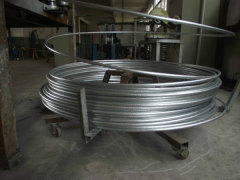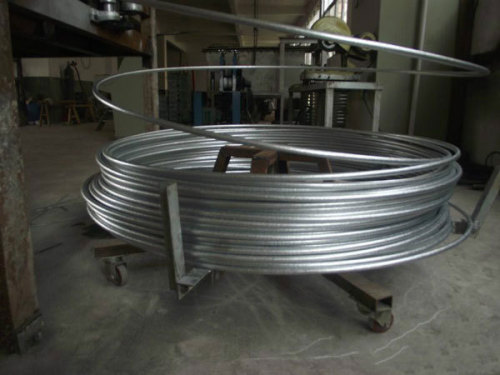Ningbo Zhenhai Beisuda Petrochemical Equipment Co.,Ltd, copper clad steel wire suppliers, located in Ningbo, Zhejiang, it is a professional enterprice, who focus on R&D, production, sales copper clad steel series grounding products. We provide CCS Round Wire, CCS-Stranded Cable, copper clad steel earth rod and so on. Want to know more? Please contact us. We also provide copper clad welding wire, copper clad stainless steel wire, stainless steel ground wire, cald weld molds,etc. And the clad steel definition is excellent.
0.8 Series CCS Round Wire
Origin of new ccs material development
0.8mm series copper-clad round wire is a new type of material developed by our Company to replace pure copper. Because it has the advantages of high strength, low price, high corrosion resistance and high conductivity of copper, and meanwhile its comprehensive performance is high and its cost is more economical than pure copper grounding device, it has been widely used in UHV lines, petrochemical industry, nuclear power and high-speed railway, especially in key projects in recent years.
Copper-clad steel:
The material in which the surface of a steel core is uniformly coated with copper includes copper-clad steel bars (for vertical grounding electrode only), copper-clad steel tape, and copper-clad steel wires (including round wires and stranded wires). According to the production process, it can be divided into continuous casting copper-clad steel and electroplating copper-clad steel.
CCS Round Wire
Development of copper-clad steel grounding device
With the increasing voltage level of power lines and the increasing capacity of the system, higher requirements are put forward for the safety and reliability of grounding devices.
The traditional method in foreign countries is to use pure copper as the grounding material, but pure copper is expensive and it is a strategic resource, which is not suitable for being massively used as grounding devices in China. From 1910 to 1955, National Bureau of Standards (NBS) conducted corrosion resistance studies of grounding bodies. 36,500 samples collected at 128 test sites throughout the United States represented 333 metal materials consisting of iron, non-ferrous metals and protective coatings, respectively. The test results show that only steel bars and stainless steel bars with copper plating thickness over 0.5mm can be accepted.
In addition, continue the statistical data of 8 to 30 years and take the test results of 43 copper samples in different soils, 41 of which were calculated, to get the 0.17mm average pitting depth of 30 years. Therefore, some international standards have determined the thickness of copper coating of copper-clad steel material to be at least 0.25 mm. Considering the hard friction during construction, it is suggested that the thickness of copper coating be defined as 0.5-0.8 mm.
In China, copper clad(copperweld) steel materials are widely used in substation grounding grids in areas with high soil resistivity. Because of the characteristics of UHV project, such as high voltage level, large capacity and short power cut window period, combined with the corrosion intensity of groundwater in the area, copper-clad steel grounding devices have been applied in UHV lines and many UHV lines in China use copper-clad steel materials as grounding bodies.
Development of copper-clad steel grounding device
Comparison between copper-clad steel grounding and traditional hot-dip galvanized steel grounding device
1. Corrosion rate comparision
Material | Beijing Liangxiang | Tianjing Dongli |
Stainless stell | 0.002 | 0.003 |
Pure coper | 0.001 | 0.001 |
Copper-cald stell | 0.001 | 0.001 |
Galvanized steel | 0.176 | 0.2 |
Annual corrosion rate of grounding materials in some place of Beijing and Tianjin
The test results show that galvanized steel has the most serious corrosion and its corrosion rate is more than 50 times higher than that of pure copper; the corrosion degree of stainless steel is much lower than that of pure copper and copper-clad steel, showing good corrosion resistance; as a copper-steel composite material, the self-corrosion potential of copper-clad steel in soil is basically the same as that of pure copper, and its corrosion rate is the same as that of pure copper; the corrosion rate of the electroplated copper-clad steel with thinner coating is higher than that of the continuous casting copper-clad steel with thicker coating.
2. Analysis and comparison of physical performance in short circuit
If the conductivity of copper were 100% and the conductivity of standard 1020 steel were only 10.8%, the conductivity of copper would be about 10 times that of steel. However, the conductivity of the 30% conductivity copper-clad round wire would be 30%, and the conductivity of the 40% conductivity copper-clad round wire would be 40%, which would be far better than the steel grounding body. Especially under skin effect, the conductivity of copper-plated strands at high frequencies would be much better than that of steel, that is, the conductivity of copper grounding body would be better than that of steel grounding body. The melting point of copper is 1083℃ and the maximum allowable temperature during short circuit is 450℃ ; the melting point of steel is 1510℃ and the maximum allowable temperature during short circuit is 400℃. Therefore, when the grounding body has the same cross section, the copper-clad steel grounding material has better thermal stability.
3. Economic comparison
According to Appendix D of Technical Conditions for Copper-clad Steel for Grounding in Electrical Engineering, the corrosion rates of copper clad steel in different soils are calculated according to the reference values in table. Corrosion rate of pure copper under different soil corrosion grades (mm/a)
Soil corrosion grade | La extremely weak corrosion | Lb Weak corrosion | II Strong corrosion | III Extremely strong corrosion |
Corrosion rate | 0.0004-0.001 | 0.001-0.004 | 0.004-0.007 | 0.007-0.021 |
The 0.8mm copper plating thickness is enough to meet the requirement of 60 years of service under the grade of III extremely strong corrosion.
The corrosion rate of galvanized steel is nearly 50 times that of copper-clad steel under the same soil conditions, and the grounding body should be overhauled after being used for 3-5 years.
The State Grid has accounted the UHV tower according to the drawings: after the investigation of the market price of material during the construction, the market price of the copper-clad-steel grounding body is calculated at RMB 20 /m, the market price of φ12 galvanized-steel round steel grounding body is calculated at RMB 6 /m and the grounding body laying is calculated according to the grounding construction drawing. During the 30-year whole life cycle, galvanized steel is overhauled every 5 years, of which the cost of material is RMB 20 /m for copper-clad steel and RMB 36/m for galvanized steel, that is, only material cost can be reduced by 80%. Galvanized steel can be overhauled and replaced six times. If the construction cost is RMB 70 /m3 for earthwork and stone works and each base tower is calculated by 23 m3 for excavation, RMB 9660 per base tower will be saved.
Copper-clad steel construction
The horizontal laying of the copper-clad steel grounding device is the same as that of the ordinary galvanized round steel, where only the connection method is changed to hot-melt welding, which has reduced the contact resistance between the joints and is more conducive to the release of lightning current.
Copper-clad steel constructionCopper-clad steel construction
Exothermic welding, also known as "aluminum heat welding", is a simple, high-efficiency, high-quality metal joining process that has been mass-produced and used in China in recent years. Exothermic welding uses chemical reaction heat of metal compounds as heat source and through superheated (reduced) molten metal or indirect heating, a certain shape and size of the melted joint is formed in the cavity of the special graphite mould, which meets the engineering requirements, and finally through cooling and condensation, the welding process is realized. At present, exothermic welding has generally replaced the mechanical connection between metals in the past.







